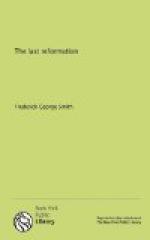In another place the same historian, speaking of the absence of truth and the prevalence of error in the third century, says: “It is vain to expect Christian faith to abound without Christian doctrine. Moral and philosophical and monastical instructions will not effect for men what is to be expected from evangelical doctrine. And if the faith of Christ was so much declined (and its decayed state ought to be dated from about the year 270,) we need not wonder that such scenes as Eusebius hints at without any circumstantial details, took place in the Christian world.”—Century IV, Chap. I. (Parenthetical clause is Milner’s; italicizing, mine.) In addition to this quotation, and as if to give emphasis, the historian places prominently in a side-head the words, “Decay of pure Christianity, A.D. 270.”
Measuring forward from A.D. 270 the alloted period of twelve hundred and sixty years brings us to A.D. 1530, a year which marked the beginning of Protestantism in its organized form. The first Protestant creed, the Confession of Augsburg, was made that year.
The description of the papal power under the symbol of the ten-horned beast of Revelation 13 and the little horn of Daniel 7 presents a melancholy picture of world-events during the long period of twelve hundred and sixty years ending with the sixteenth century reformation.
[Sidenote: Principle of parallelism]
Before proceeding to give in chronological order a description of events following the reign of the beast, I wish to call attention to an important plan followed in the Biblical presentation of prophetic truth; namely, that the events are taken up by parallel series covering the same period of time. But in addition to this point, we observe the principle of contrast. When the history of political events is described, we have in contrast therewith a description of ecclesiastical events; and with the representation of a false church or an apostate state of Christianity, we have in immediate contrast the history of God’s chosen people. Or perhaps the order is reversed, but the principle remains the same. While, in the nature of things, these distinct lines can not always be well represented symbolically as occurring at the same time, they are presented in parallel series, thus proving that they were to be fulfilled simultaneously.
In direct contrast with the power of apostate Christendom represented by the papacy, which for certain reasons I have presented first, we have in chapter 11 of the Revelation a brief history of God’s true people that existed during the papal reign. In this case, however, a description of the apostasy and of the true church are presented in the same series and in such a way as to give special emphasis to the point of contrast as well as to prove their simultaneous fulfilment. Thus we read: “And there was given me a reed like unto a rod: and the angel stood, saying, Rise, and measure the temple of God, and the altar, and them that worship therein. But the court which is without the temple leave out, and measure it not; for it is given unto the Gentiles: and the holy city shall they tread under foot forty and two months. And I will give power unto my two witnesses, and they shall prophecy a thousand two hundred and three score days, clothed in sackcloth” (chap. 11:1-3).




